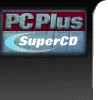 
|

| IE 4 Shell Integration - The Start Menu, Task
Bar and Desktop Toolbars, continued  The Links toolbar is
similar to the Quick Launch toolbar (see part 1), but has a special relationship with IE
4. You can also create your own toolbars, either from the contents
of a disk folder or - with amazing results - from a Web page. The Links toolbar is
similar to the Quick Launch toolbar (see part 1), but has a special relationship with IE
4. You can also create your own toolbars, either from the contents
of a disk folder or - with amazing results - from a Web page.
|
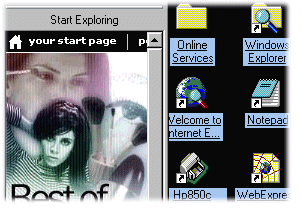 |
 The Links Bar The Links BarLike
the Address bar, the Links bar is a piece of the IE
4 browser that's been promoted to free-standing status. Its function is straightforward -
click on an item in the Links bar, and the target Web page is opened in the browser
window.
Although the Links bar's main purpose is to hold links to Web pages,
the target of a Links bar item doesn't have to be on the Web. Like the Quick Launch bar, the Links bar can hold links to any 'object',
including local folders and files. 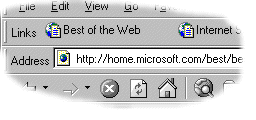 The major difference between the Links and
Quick Launch bars is that the Links bar can also appear as an integral part of the browser
window (right). The major difference between the Links and
Quick Launch bars is that the Links bar can also appear as an integral part of the browser
window (right). |
 Creating a new Web page link on the Links bar is the same
process as creating one on the other toolbars - just open the page in the IE browser and
drag the current page icon onto the bar. Creating a new Web page link on the Links bar is the same
process as creating one on the other toolbars - just open the page in the IE browser and
drag the current page icon onto the bar.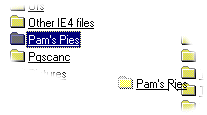 Adding a link to a folder or file
is easy too - just find the item in a browse window (or Windows Explorer) and drag it onto
the Links bar. Adding a link to a folder or file
is easy too - just find the item in a browse window (or Windows Explorer) and drag it onto
the Links bar.
|
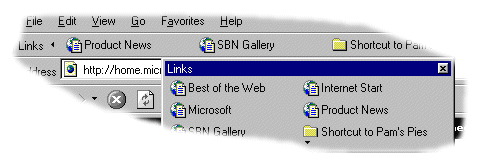 Whatever type of item you link to, the link buttons appear
on both the free-standing and browser-based versions of the Links bar. Whatever type of item you link to, the link buttons appear
on both the free-standing and browser-based versions of the Links bar. |
  Creating your own custom toolbars Creating your own custom toolbars
As well as using the four standard desktop toolbars, you can
create your own.
To create a new toolbar, right-click on the Task Bar and choose Toolbars...
New Toolbar... from the pop-up menus. This opens the New Toolbar dialog (below). |
 You can create two types of custom toolbar. The first
displays a Web page in a movable, dockable viewport - it's the kind we've just seen in 'and now for something completely different' above. You can create two types of custom toolbar. The first
displays a Web page in a movable, dockable viewport - it's the kind we've just seen in 'and now for something completely different' above.  To
create a page-based toolbar, type or paste a Web page address (either on the Internet or
the name of an HTML file on your local disk) into the box at the top of the dialog. To
create a page-based toolbar, type or paste a Web page address (either on the Internet or
the name of an HTML file on your local disk) into the box at the top of the dialog. |
 The other type of custom toolbar is based on the contents
of a folder of your choice on your local disk. The other type of custom toolbar is based on the contents
of a folder of your choice on your local disk.Create the
folder first, and fill it with shortcuts ('links') to things you want to open - disk
drives, folders, applications, documents, Web pages, anything you like.
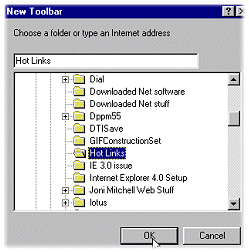
Now open the New Toolbar dialog, browse your way to your
folder, and clck OK. |
This creates a toolbar 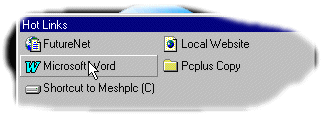 (below)
with a button for each shortcut in your folder. Like the buttons on the Quick Launch and
Links bars, the buttons on a custom bar can point to a variety of object types - when you
click on one, Win 95 opens it in the appropriate way (browser window for disk folders and
Web pages, an application for a document, etc). (below)
with a button for each shortcut in your folder. Like the buttons on the Quick Launch and
Links bars, the buttons on a custom bar can point to a variety of object types - when you
click on one, Win 95 opens it in the appropriate way (browser window for disk folders and
Web pages, an application for a document, etc).You can add
items to a custom toolbar by dragging them onto it (drag the current page icon from a Web
browsing window to add a Web page, drag a folder or file name from a disk browsing window
to add a shortcut to a disk object). Alternatively you can add items to the folder on
which the toolbar is based, using the normal disk filing tools (browse windows or Windows
Explorer). Click here for more details on adding items to desktop
toolbars. To remove an item from a custom toolbar, right-click on its button and
choose Delete from the pop-up menu. The item will be physically removed from the
folder on which the toolbar is based.
|
|
|
|



